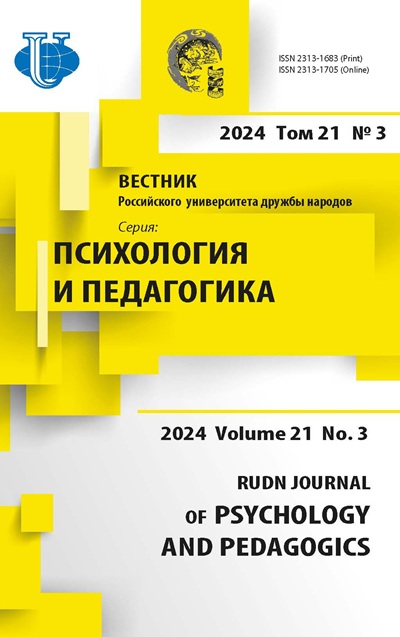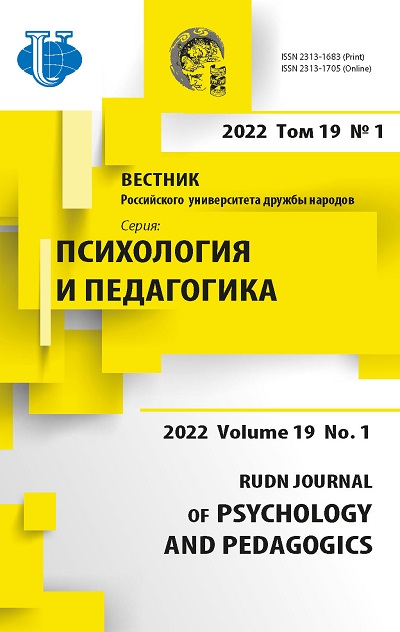Cognitive and Motivational Foundations Underlying Acculturation Expectations: Applications of Ethnic Group Position Model
- Authors: Grigoryev D.S.1
-
Affiliations:
- National Research University Higher School of Economics
- Issue: Vol 19, No 1 (2022)
- Pages: 86-109
- Section: PERSONALITY IN INTERCULTURAL COMMUNICATION
- URL: https://journals.rudn.ru/psychology-pedagogics/article/view/30742
- DOI: https://doi.org/10.22363/2313-1683-2022-19-1-86-109
Cite item
Full Text
Abstract
Although dominant cultural groups as a rule have the main impact on the mutual acculturation process, they receive much less attention in the literature. This article, firstly, challenges the common implicit position that dominant cultural groups do not have variety in their acculturation expectations regarding different non-dominant cultural groups, and, secondly, proposes Ethnic Group Position Model (EGPM) to explain and predict acculturation expectations regarding a particular non-dominant cultural group in society. The empirical study tests the relationship of structural variables of the group position by the new model (status, interdependence, similarity) and acculturation expectations while taking into account the relevant individual difference variables (the degree of agreement and endorsement for authoritarian attitudes and intergroup ideologies), thus covering the cognitive and motivational foundations underlying acculturation expectations. The participants in the survey were 377 Russian representatives of the dominant cultural group in Russia, who filled out a questionnaire containing questions about acculturation expectations (e.g., integration, assimilation, separation), evaluation of ethnic groups according to the feelings thermometer, perceived group positions, and also about an endorsement of authoritarian attitudes (right-wing authoritarianism and social domination orientation) and intergroup ideologies (e.g., assimilationism, multiculturalism, interculturalism). The results showed that Russians did vary their acculturation expectations towards different cultural groups according to the EGPM, even when controlling for their individual differences in ethnic bias. The conclusions emphasize that the cultural groups’ images are steam from ordinary observations of their life outcomes or circumstances, primarily in terms of vertical inequality (prestige and respect), i.e. perceived status (e.g., education, professional prestige, connection with crime), which largely shapes intercultural relations and in particular acculturation expectations.
About the authors
Dmitry Sergeevich Grigoryev
National Research University Higher School of Economics
Author for correspondence.
Email: dgrigoryev@hse.ru
ORCID iD: 0000-0003-4511-7942
PhD, is Research Fellow of the Center for Sociocultural Research
20 Myasnitskaya St, Moscow, 101000, Russian FederationReferences
- Alcott, Y.D., & Watt, S.E. (2017). Acculturation strategy and racial group in the perception of immigrants. Journal of Pacific Rim Psychology, 11, 1–16. https://doi.org/10.1017/prp.2017.2
- Arends-Tóth, J., & van de Vijver, F. (2006). Assessment of psychological acculturation. In D.L. Sam & J.W. Berry (Eds.), The Cambridge Handbook of Acculturation Psychology (pp. 142–160). Cambridge University Press. https://doi.org/10.1017/CBO9780511489891.013
- Batkhina, A., Berry, J.W., Jurcik, T., Dubrov, D., & Grigoryev, D. (in press). More similarity if different, more difference if similar: Assimilation, colorblindness, multiculturalism, polyculturalism, and generalized and specific negative intergroup bias. Europe’s Journal of Psychology. http://doi.org/10.5964/ejop.3715
- Berry, J.W. (1997). Immigration, acculturation, and adaptation. Applied Psychology: An International Review, 46(1), 5–34. https://doi.org/10.1080/026999497378467
- Berry, J.W. (2006). Mutual attitudes among immigrants and ethnocultural groups in Canada. International Journal of Intercultural Relations, 30(6), 719–734. https://doi.org/10.1016/j.ijintrel.2006.06.004
- Berry, J.W. (2019). Ecocultural psychology (D. Grigoryev, Transl. from Eng.). Cultural-Historical Psychology, 15(4), 4–16. (In Russ.) https://doi.org/10.17759/chp.2019150401
- Berry, J.W., & Kalin, R. (1979). Reciprocity of inter-ethnic attitudes in a multicultural society. International Journal of Intercultural Relations, 3(1), 99–111. https://doi.org/10.1016/0147-1767(79)90048-8
- Berry, J.W., & Sabatier, C. (2011). Variations in the assessment of acculturation attitudes: Their relationships with psychological wellbeing. International Journal of Intercultural Relations, 35, 658–669. https://doi.org/10.1016/j.ijintrel.2011.02.002
- Berry, J.W., Grigoryev, D., Grigoryan, L., Zabrodskaja, A., & Fiske, S.T. (Eds.) (2021). Stereotypes and intercultural relations: Interdisciplinary integration, new approaches, and new contexts. Lausanne, Switzerland: Frontiers Media SA. http://doi.org/10.3389/978-2-88971-353-0
- Blumer, H. (2008). Race prejudice as a sense of group position (V. Nikolaev, Transl. from Eng.). Social and Humanitarian Sciences. Sociology, 11(4), 141–151. (In Russ.)
- Brown, R., & Zagefka, H. (2011). The dynamics of acculturation: An intergroup perspective. In J.M. Olson & M.P. Zanna (Eds.), Advances in Experimental Social Psychology (vol. 44, pp. 129–184). San Diego, CA: Academic Press. https://doi.org/10.1016/B978-0-12-385522-0.00003-2
- Filippova, E.I. (2014). Mul'tikul'turalizm kak politika i kak figura rechi. Herald of the Russian Nation, 2, 127–137. (In Russ.)
- Fiske, S.T. (1993). Controlling other people: The impact of power on stereotyping. American Psychologist, 48(6), 621–628. https://doi.org/10.1037/0003-066X.48.6.621
- Fiske, S.T. (2015). Intergroup biases: A focus on stereotype content. Current Opinion in Behavioral Sciences, 3, 45–50. https://doi.org/10.1016/j.cobeha.2015.01.010
- Fiske, S.T. (2017). Prejudices in cultural contexts: Shared stereotypes (gender, age) versus variable stereotypes (race, ethnicity, religion). Perspectives on Psychological Science, 12(5), 791–799. https://doi.org/10.1177/1745691617708204
- Fiske, S.T., Cuddy, A.J.C., Glick, P., & Xu, J. (2002). A model of (often mixed) stereotype content: Competence and warmth respectively follow from perceived status and competition. Journal of Personality and Social Psychology, 82(6), 878–902. https://doi.org/10.1037/0022-3514.82.6.878
- Grigoryev, D. (2017). Development of a short version of the dual process model scales: Right-wing authoritarianism, social dominance orientation, dangerous and competitive worldviews. National Psychological Journal, 28(4), 30–44. (In Russ.) http://doi.org/10.11621/npj.2017.0403
- Grigoryev, D. (2020a). Views on cultural diversity as well as authoritarian and ethnocentric attitudes of Russians. RUDN Journal of Psychology and Pedagogics, 17(3), 473–490. (In Russ.) http://doi.org/10.22363/2313-1683-2020-17-3-473-490
- Grigoryev, D. (2020b). The Stereotype Content Model and ethnic stereotypes in Russia. The Journal of Sociology and Social Anthropology, 23(2), 215–244. (In Russ.) http://doi.org/10.31119/jssa.2020.23.2.9
- Grigoryev, D. (2020с). Problems of conceptualisation and operationalisation of attitudes toward immigrants in cross-national comparative research. Journal of the Belarusian State University. Sociology, 3, 89–100. (In Russ.) http://doi.org/10.33581/2521-6821-2020-3-89-100
- Grigoryev, D., & Berry, J.W. (2021). A taxonomy of intergroup ideologies. Cultural-Historical Psychology, 17(4), 7–15. http://doi.org/10.17759/chp.2021170401
- Grigoryev, D., Batkhina, A., van de Vijver, F., & Berry, J.W. (2020). Towards an integration of models of discrimination of immigrants: From ultimate (functional) to proximate (sociofunctional) explanations. Journal of International Migration and Integration, 21(3), 667–691. https://doi.org/10.1007/s12134-019-00677-w
- Grigoryev, D., Fiske, S.T., & Batkhina, A. (2019). Mapping ethnic stereotypes and their antecedents in Russia: The Stereotype Content Model. Frontiers in Psychology, 10(1643), 1–21. https://doi.org/10.3389/fpsyg.2019.01643
- Kozlova, M., & Ryabichenko, T. (2021). Ideologies of intergroup relations in pedagogical discourse: Representation of cultures and intercultural interaction in the educational books for migrant children. Journal of Intercultural Communication Research, 50(6), 541–555. http://doi.org/10.1080/17475759.2021.1910065
- López-Rodríguez, L., & Zagefka, H. (2015). The effects of stereotype content on acculturation preferences and prosocial tendencies: The prominent role of morality. International Journal of Intercultural Relations, 45, 36–46. https://doi.org/10.1016/j.ijintrel.2014.12.006
- Montreuil, A., & Bourhis, R.Y. (2001). Majority acculturation orientations toward “valued” and “devalued” immigrants. Journal of Cross-Cultural Psychology, 32(6): 698–719. https://doi.org/10.1177/0022022101032006004
- Novikov, A.L., & Novikova, I.A. (2019). Ethnic stereotypes in intercultural communication: Psychological and semantic aspects. RUDN Journal of Language Studies, Semiotics and Semantics, 10(4), 977–989. https://doi.org/10.22363/2313-2299-2019-10-4-977-989
- Shamionov, R.M. (2018). Formation of discriminatory personal attitudes in the process of socialization. Izv. Saratov Univ. (N.S.), Ser. Educational Aсmeology. Developmental Psychology, 7(2-26), 129–135. (In Russ.) https://doi.org/10.18500/2304-9790-2018-7-2-129-135
- Sinn, J.S., & Hayes, M.W. (2018). Is political conservatism adaptive? Reinterpreting right-wing authoritarianism and social dominance orientation as evolved, sociofunctional strategies. Political Psychology, 39, 1123–1139. https://doi.org/10.1111/pops.12475
- van Osch, Y.M.J., & Breugelmans, S.M. (2012). Perceived intergroup difference as an organizing principle of intercultural attitudes and acculturation attitudes. Journal of Cross-Cultural Psychology, 43(5), 801–821. https://doi.org/10.1177/0022022111407688
















